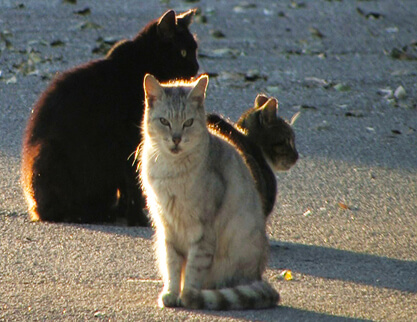Feral Cat Colonies Present Perfect Storm of Rabies Risk
MEDIA RELEASE
Contact: Robert Johns, 202-234-7181 ext.210,
 |
| Feral cats by Greg Homel |
(Washington, D.C., September 21, 2011) Feral cat colonies bring together a series of high risk elements that result in a ‘perfect storm' of rabies exposure, according to Steve Holmer, senior policy analyst at American Bird Conservancy. Holmer's assertion is part of his presentation, called “Managed Cat Colonies and Rabies,” that is one of 28 presentations being aired in over 70 countries in connection with the second annual World Rabies Day International Webinar to be held September 21 and 22.
Managed cat colonies are becoming common in most major U.S. cities and are usually operated by volunteers who like to feed cats, rely on a scheme called Trap, Neuter, Release (TNR), whereby cats are trapped, neutered, and then returned to the outdoors. Unfortunately, these cats are often not vaccinated against rabies. Even when they are vaccinated when first trapped, re-trapping cats to revaccinate can be problematic as the cats become wary of the traps. There is also typically not the funding or infrastructure among the colony feeders to repeatedly re-trap cats to administer vaccines.
Peer reviewed studies have shown that over time, cat colonies increase in size, the result of the inability to neuter or spay all the cats and the dumping of unwanted cats at the colony sites by callous pet owners. The result is a large number of unvaccinated cats.
“While cats make up a small percentage of rabies vectors, they are responsible for a disproportionate number of human exposures,” said Holmer. According to the Centers for Disease Control and Prevention, most people are exposed to rabies due to close contact with domestic animals such as cats and dogs. Although dogs historically posed a greater rabies threat to humans, dog-related incidents have become less frequent in recent decades, dropping from 1,600 cases in 1958 to just 75 in 2008. Meanwhile, cases involving cats have increased over the same period with spikes of up to 300 cases in a single year.
“Managed colonies teach feral cats to associate with humans, and while most people will not interact with wildlife, especially animals displaying erratic behavior, cats are perceived as domestic and approachable,” Holmer says.
When humans establish outdoor feeding stations for feral cats, they provide a catalyst for rabies transmission. Rabies is passed from the wildlife that is attracted to the food to the cats, and from the cats to people. According to the Center for Disease Control, cats are now the most common vector for the spread of rabies from a domestic species. In 2009 alone, there were seven accounts of rabid cats attacking people on the East Coast. As a rabies vector species, domestic cats pose a threat to human health that can be addressed by responsible pet ownership.
“Managed feral cat colonies bring together all the elements necessary to create a perfect storm of risk: concentrated numbers of unvaccinated cats, wildlife vector species attracted to food sources provided for the cats, proximity to humans, and contact among all three of these groups. Feral cat colonies only strengthen the chain of rabies transmission,” Holmer said.
“The increase in the cases of human rabies exposure from feral cats should be a concern to city and other government officials. This problem will only get worse as managed feral cat colonies grow in number because half truths about their impacts and implications on local communities and the environment is accepted by decision makers who mistakenly believe they are receiving full disclosure,” said Holmer.
In addition to posing a rabies risk, outdoor and feral cats that number at least 95 million animals in the United States, are responsible for killing an estimated 500 million birds annually in addition to scores of other small animals. Outdoor cats are responsible, in part or in whole, for the extinction of at least 33 species of birds.
There is no cost to speakers or attendees for the World Rabies Day Webinar, and all presentations will be recorded and made available via the World Rabies Day website. There is no cost to attend the live interactive Webinars but you will need to register. REGISTER HERE . For more information about World Rabies Day, go to: www.worldrabiesday.org
Holmer's presentation, which will include questions and answers, is scheduled for 11:00 – 11:25 EDT on Thursday, September 22.


















































